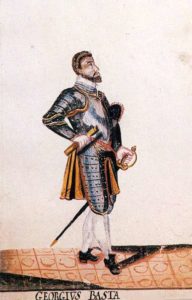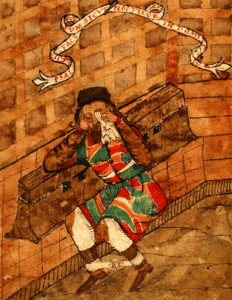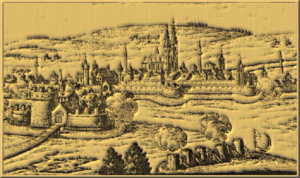The Long War, Part 30 / Székesfehérvár fell again, 1602

Summer, 1602: the Christian troops were coming together very slowly again so the campaign could be started only later. They had two goals, the main army was supposed to go against Buda Castle while the army of General Basta was to continue its fight in Transylvania. (See my next article about Basta’s victory there where he defeated the Transylvanian army at Tövis (Teiuș, Dreikirchen).

Unfortunately, the hero of the previous year, Prince Mercoeur passed away during the first part of the year. Finally, Archduke Matthias has appointed Hermann Russwurm who had proved himself already in the battles of Fehérvár (aka Székesfehérvár) and at the siege of Kanizsa.
The Habsburgs had smaller units and they were trying to ambush the enemy but all their major attacks against Simontornya in April and against Dunaföldvár, Adony were unsuccessful.

As for the enemy, it was Jemiscsi Haszán, the commander of the previous year’s campaign who led their troops. He had wintered in Belgrade with his army and he set out from there at the end of June. They aimed to take Fehérvár Castle back. Reaching the fort, the soldiers of the Pasha of Buda, Beglerbey Lala Mehmed, and the troops of the Pasha of Bosnia, Beglerbey Dervis Haszán joined in. Their full number was about 40-50,000 men.
Fehérvár Castle has been defended since last year December by Colonel Giovanni Marco Isolano and his vice-captain, Wathay Ferenc became the famous warrior and poet of the Borderland. (Please, note that I use the Eastern name order for Hungarians where family names come first.) There were enough soldiers under their flags, about 3,000 men but their pay had not been settled and the renovation of the castle had not been finished, either. The Christians had tried to supply the fort before the coming siege with food and gunpowder and even the guards got paid.

The army of Haszán arrived at the fort on 11 August and the siege began on the next day. The heat of the summer had the swamps around the castle dried up which made the defenders’ position more difficult. They had already given up one of the outer cities called Beslia by 12 August. However, they repelled the Turk attack two days later which was aimed against the other outer city called Sziget (Island), although this fight required large units and a fierce fight. The Ottomans tried another assault the following day but it was fought back, too. Colonel Isolano has always appeared in the most critical moments, bringing fresh units to the walls. You can compare this fight to the first siege of Székesfehérvár when Captain Varkocs György made his last stand in 1543:
https://www.hungarianottomanwars.com/essays/a-hero-of-the-valiant-order-varkocs-ferenc/
After these failures, Hasszán began the bombardment of the walls and had the moats filled up. He launched his next attack against Sziget-outer city on 18 August. Although it was repelled, the Hajdú soldiers withdrew from this outer city and Isolano had to empty this area. Here is more about Székesfehérvár city:
https://www.hungarianottomanwars.com/ottoman-occupied-lands/szekesfehervar/
The Ottoman soldiers assaulted the Ingovány (Swamp) outer city on the next day but the defenders were able to hold it. Yet, the Colonel had this outer city also emptied because of the overwhelming numbers of the enemy.

Having taken these outer cities, the Turks deployed their cannons and began the cannonade of the inner castle on 20 August.
The artillery fire has caused severe losses to the defenders but they seemed to have remained enough strength to charge out.
They trusted in the coming reinforcement and indeed, Russwurm was intending to relieve the siege but his army was coming together very slowly. Sadly, Nádasdy Ferenc could arrive at Pápa Castle with his Styrian and Hungarian troops only after the fall of Fehérvár.

The Turks launched the general attack on 28 August. They were beaten back at the northern part but the besiegers could get into the round bastion and into the tower on the southern part of the fort. The defenders withdrew behind the inner fortifications. Their number has decreased to 700 but there were barely 300 who were not wounded of them. Although Isolano and his officers refused to surrender, the soldiers rioted and began to start talks with the Turks. However, they could not agree and when the Turks broke into the inner fort on 29 August, they took 250-300 captives and slaughtered the rest.

Isolano and his officers were taken to Istanbul. Wathay wrote his „letters of lamentation” in his captivity which he brought home later; they were published in the 1970s. The so-called Wathay Codex is a very valuable historical source, it is full of the paintings that Wathay made during his captivity. Fehérvár Castle has fallen but the besiegers had plenty of casualties. According to some (obviously exaggerated) reports they reached 20,000 men.

The Grand Vizier posted 4,000 soldiers to guard the fort, under Pasha Dervis. He was busy with the renovation of the castle during the next two weeks, then he moved towards Transylvania. Initially, he had intended to besiege Esztergom Castle in the north, so it has avoided its fate for the time being.
Source: Szibler Gábor
Dear Readers, I can only make this content available through small donations or by selling my books or T-shirts.
If you like my writings, please feel free to support me with a coffee here:
You can check out my books on Amazon or Draft2Digital, they are available in hardcover, paperback, or ebook:
https://www.amazon.com/dp/198020490X
or at https://books2read.com/b/boYd81


My work can also be followed and supported on Patreon: Become a Patron!http://Become a Patron!



